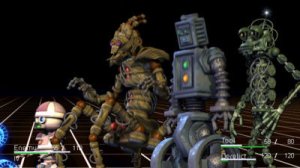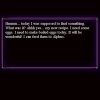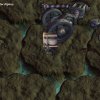On a remote deserted island, a small coffee robot is slowly becoming aware of his surroundings. He doesn’t know how long he’s been there as his internal timer hasn’t worked for long, but he knows every corner of the area by now. His days are spent obsessively collecting eggs for recipes, which he prepares for his friends Alphus, Derelict, Tool and Defect, rusted wrecks of large robots, deactivated for centuries. On some days, he senses a mysterious signal coming from under the ground. Coffee is a limited robot, but he wonders if they have been affected by a virus and if there is anything he can do to save them.
The Desolate Room, created by a single developer in Multimedia Fusion, starts as a real-time RPG. The player controls Coffee on the small island, hunting for eggs (egg finding skill is the only one he has) and certain items. There are no means of attack, no NPCs, conversations or enemies. During one of the quests Coffee salvages memory chips from the robot wrecks and attempts to retrieve memory fragments by inputting them in a console station. There the game changes into an 8-bit shooter where the player steers Coffee as a virtual avatar through different rooms. Each room consists of small bits of green code or large red ones. The virtual avatar has statistics based on health, speed and charge. The latter two statistics transcend to the real world. Coffee is able to log on or off at any time and hunt for more eggs to boost these skills. The avatar can sustain damage by red areas or by touching code. Taking out green code leaves behind bricks that fill the stats meters.
Red code is a different matter. These can either be taken out with a lot of patience, but more often they will touch the avatar, drawing it into a virtual battle against a viral element. At that point the game warps into a turn-based arena. The player no longer controls Coffee or the avatar, but the 4 robots stored in the memory chips. These are shown on the right, while the enemy appears on the left. Actions use the Active Time system, similar to most of the Final Fantasy games. Next to HP, each character has a white time meter that slowly fills up. When full, an action can be performed. These actions are based on the second meter: charge. The amount of charge determines the possible actions, so robots either choose a specific action or charge to open up more possibilities.
Each robot has 10 unique skills, all available right away at level 1, but they all require a different amount of charge to execute. There are basic attacks (static ball, quick shot, wallop), defensive measures (protowall, medbeacon, quickfix), actions that influence the opponent’s statistics (hack, disable system, intimidation, distraction) and powerful attacks that usually require a full charge (doom claw, searing beam, rupture 101, wrecking ball). Most of these can be combined and some last multiple rounds, such as a turret that keeps firing or virus damage that affects an enemy for a long time. The effect of some of the attacks is further determined through 5-second 8-bit mini-games where the player has to shoot or avoid enemies to influence the strength of the attack. The game is entirely played with the same party, there is always only one enemy at a time and opponents fights using the same mechanics with all statistics shown. After each fight tokens are awarded based on skill, combo and difficulty. These can be used to upgrade any of the skills to the combination of actions that suits you best as a player.
The virtual world in the console consists of different stages with different colours, guarded by boss code. After each boss battle, the avatar can dive deeper and a memory fragment is unlocked, a cut-scene that shows what has happened to the robots. These sequences introduce a fifth robot not present on the island and Coffee has to discover how he’s related to the virus and where the party of robots failed in their quest.




